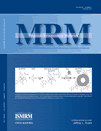Immobilized contrast-enhanced MRI: Gadolinium-based long-term MR contrast enhancement of the vein graft vessel wall
Abstract
An implantable MR contrast agent that can be covalently immobilized on tissue during surgery has been developed. The rationale is that a durable increase in tissue contrast using an implantable contrast agent can enhance postsurgical tissue differentiation using MRI. For small-vessel (e.g., vein graft) MRI, the direct benefit of such permanent “labeling” of the vessel wall by modification of its relaxation properties is to achieve more efficient imaging. This efficiency can be realized as either increased contrast leading to more accurate delineation of vessel wall and lesion tissue boundaries, or, faster imaging without penalizing contrast-to-noise ratio, or a combination thereof. We demonstrate, for the first time, stable long-term MRI enhancement using such an exogenous contrast mechanism based on immobilizing a modified diethylenetriaminepentaacetic acid gadolinium3+ dihydrogen complex on a human vein using a covalent amide bond. Signal enhancement due to the covalently immobilized contrast agent is demonstrated for excised human vein specimens imaged at 3 T, and its long-term stability is demonstrated during a 4-month incubation period. Magn Reson Med, 2010. © 2010 Wiley-Liss, Inc.




